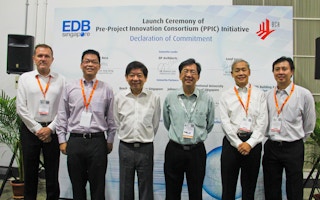Singapore’s economic agency has launched a new initiative called the ‘Pre-Project Innovation Consortium’ (PPIC), which will promote the concept of integrative design and enable building industry players to collaborate on cutting-edge sustainable buildings at the early design stage.
Announcing it at the International Green Building Conference in Singapore on Monday, the Economic Development Board (EDB) said the PPIC initiative was the first of its kind in the world and follows Singapore’s ambition to encourage inter-disciplinary innovations and integrative design in green buildings.
Chief executive of the Building and Construction Authority (BCA), Dr John Keung, said the initiative “reinforces the importance of doing things right from the start in the construction process”.
“Incorporating the fundamentals of sustainability at the pre-project design and planning stage will lead to cost-effective and high performance green buildings,” he added.
At the heart of the PPIC is the integrative design process, which EDB noted will enable Singapore to lead the commercialisation of green building technologies customised for the tropical climate.
Integrative design is a holistic method for designing buildings which meet sustainable design objectives that are environmentally, socially, and financially responsible.
EDB executive director of Cities, Infrastructure and Industrial Solutions, Goh Chee Kiong, explained to Eco-Business that innovation in the building industry is often done in silos and by the time projects are awarded, it is too late to implement innovations due to cost and contractual obligations.
“So the PPIC addresses this and brings together like-minded companies to come up with a holistic blueprint that integrates elements like building control, cooling systems, building materials and lighting from the onset,” he said. This blueprint can then be replicated in future building designs, he added.
The first two groups under the PPIC are led by three building industry heavyweights: Australia-based leading integrated property developer Lend Lease will be leading one consortium to focus on commercial (offices), education and healthcare facilities; while the second consortium, jointly led by Singapore-based DP Architects and New Zealand-based engineering consultancy Beca, will be focusing on commercial (retail) and healthcare facilities.
Companies participating include 3M, Asahi Glass Company, Bosch, Holcim, Johnson Controls, Philips Lighting and United Technologies’ Building & Industrial Systems.
“
Incorporating the fundamentals of sustainability at the pre-project design and planning stage will lead to cost-effective and high performance green buildings
Dr John Keung, chief executive, Building and Construction Authority
These two consortia are projected to spend S$10 million in research over the next three years.
Francis Lee, CEO of DP Architects, said, “The PPIC initiative will greatly facilitate access to manufacturers of innovative building material with established R&D facilities in Singapore. This will accelerate the process to bring new solutions to realisation.”
EDB said a few companies in the PPIC already plan to test-bed, for example, the use of Cross Laminated Timber (CLT) in Singapore. CLT is made from timber and has the same structural strength as concrete. It is formed by binding layers of timber with non-toxic adhesives and then hydraulically pressing the layers together.
CLT is built cleaner, quieter and up to 40 per cent faster than concrete and steel structures. Apart from being a good insulator of heat, CLT also prevents air leakage from walls, roofs and windows, so the stable temperatures also lowers air conditioning costs.
As it was initially developed using Austria-imported wood, it needs to be adapted for Singapore’s hot and humid weather using regionally-sourced wood, customised coatings and adhesives.
Rod Leaver, CEO Asia, Lend Lease, said the firm was excited to introduce CLT to Singapore. It had completed Forté at Victoria Harbour in 2012, which is Australia’s first and also the world’s tallest timber apartment building.
“CLT could revolutionise the built environment in Singapore by delivering a quantum leap of up to 40 per cent improvement in construction productivity, in a sustainable way. Through this consortium, we hope to create a CLT Living Lab to partner with the industry and academic partners in further creating smart, innovative and sustainable buildings for the future.”
How PPIC works
Source:EDB
In the PPIC, there will be a Consortium Lead to identify problem statements and research topics. Developers and architects are usually selected to lead the consortium because their job scopes require them to set the vision for building projects.
Each Consortium Lead will partner building technologies and material players with meaningful R&D and engineering capabilities in Singapore to co-develop prototypes. The prototypes and research outcomes could then be deployed in projects of the Consortium Leads in Singapore and across the region.
Through the PPIC, building technologies and materials companies will improve the commercialisation prospects for their innovative and sustainable building solutions.
At the same time, the Consortium Leads will be able to differentiate their development projects. This creates a win-win situation where all players in the building ecosystem can benefit from their participation in the PPIC.
Our special event coverage of the International Green Building Conference 2014 is brought to you by City Developments Limited (CDL).













